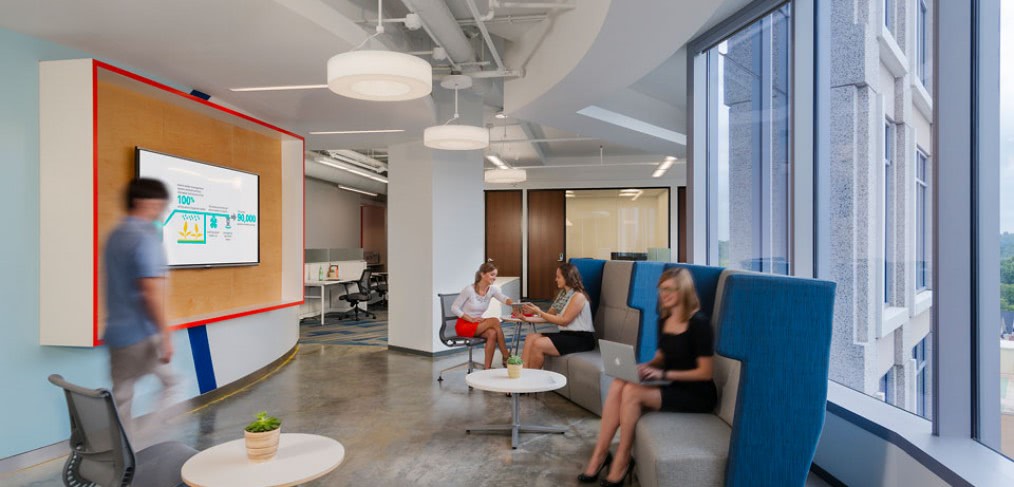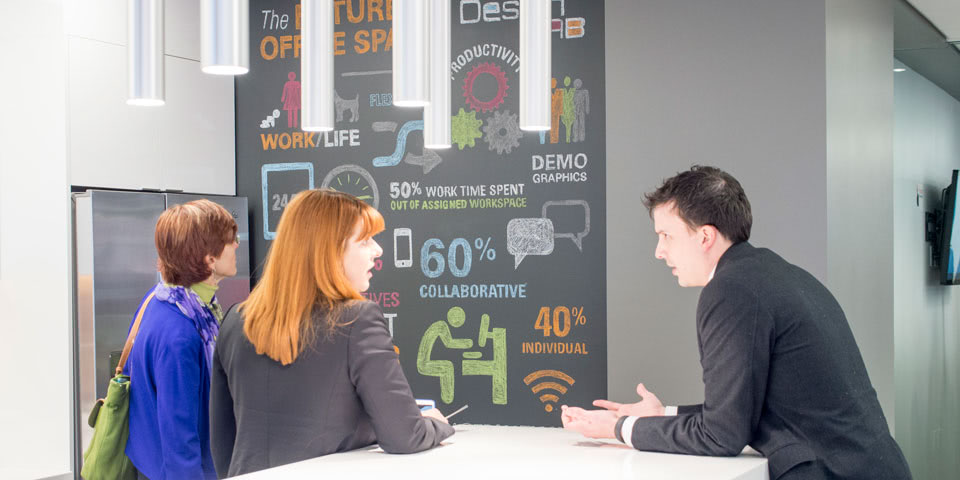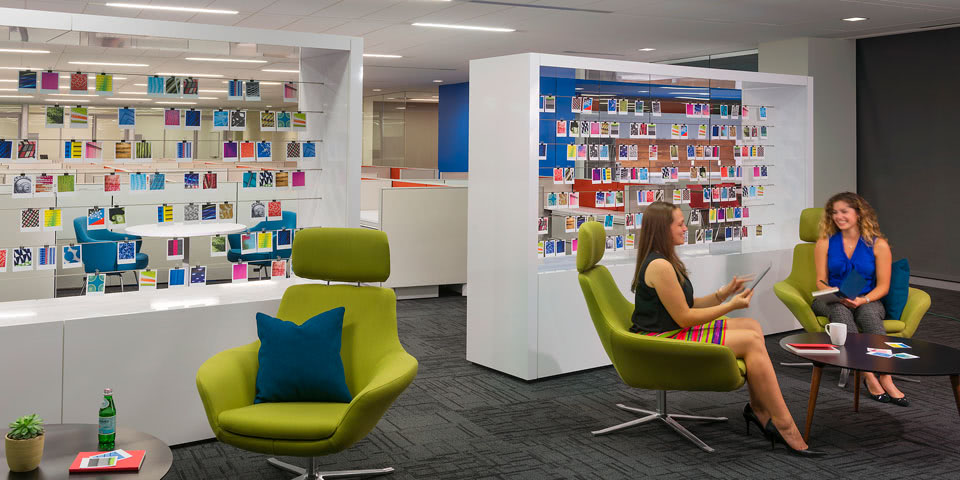
2015 Trends in the Workplace
The workplace continues to evolve as new age groups, technologies and work styles enter the mix. As a result, businesses are finding it essential to respond to these changes with environments that work for this new crop of needs. With so many new issues to think about, where should business leaders direct their attention? For many, focusing on the issues related to the individual employee experience will help increase overall satisfaction and have a positive impact on the organization’s bottom line.
Wellbeing Overtakes Wellness
Last year, we discussed the expansion of health and wellness programs. For 2015 and beyond, we expect a greater emphasis on total wellbeing, rather than simply examining ways to positively impact employee health. Wellness is fairly easy to understand and measure. It also has an impact on an employee’s health status, influencing their work behavior, attendance and performance/productivity.
However, focusing on wellness itself is not enough. Addressing wellbeing is also critical to ensure companies’ most expensive asset, the people, is maximized. One of the most buzzed-about presentations at CoreNet Global’s 2014 North American Summit was a presentation featuring two fascinating scientists: Sally Augustin founder of Design With Science and Cristina Banks of the University of California – Berkeley’s Interdisciplinary Center for Healthy Workplaces. The scientists dug into how workplaces can better promote physical health as well as mental and social wellbeing.
And an investment in this has serious payoff. Research shows that employees are more creative, more cooperative, more helpful, take fewer sick days and are more engaged with work.
Staunching the Senior Tsunami
For the last decade, the workforce has been increasing in generational diversity. We know that there are up to five generations in the workforce, but 2015 brings more insight to the impact of this generation blending within the workplace.
- Generation Z is entering the workforce. Believe it or not, this generation is in the workplace, typically either as interns or entry-level employees
- Millennials are in leadership roles. By 2025, this generation will represent 75% of the workforce.
- Millennial values are different than those of Boomers and earlier generations: Millennials value work-life fit more than compensation growth or skill development.
Changing demographics are also leading to a shrinking talent pool, which is particularly true in the United States and many other industrialized regions (such as Europe and Japan). With the “senior tsunami” of retiring Baby Boomers and overall lower birth rates, both succession planning and finding employees with the right skills is becoming a challenge. To combat the senior tsunami, there is a dramatic increase in post-retirement consulting. Many Boomers plan to work well past 65.
The Fight for Collaborative Space
Collaboration continues to be a key emphasis for workplace design. Collaboration enhances knowledge sharing, improving productivity and innovation. Companies seek opportunities to enhance both formal and informal collaboration through the built environment. The critical issue is understanding what kind of collaboration is best for the company.
Research has shown that chance encounters actually do improve performance, and while many companies have experimented with different types of collaborative spaces the result is not always positive.
So what does this mean for workplace design?
First, greater upfront understanding of the client organization is needed to plan for the right type and mix of collaborative space. CallisonRTKL recently conducted a study for a healthcare consulting firm. The leadership and senior management were convinced that the organization needed many large, formal conference rooms. Utilization studies found that the average meeting size was 3.7 people and there were no meetings with more than 15 attendees during the study period. This trend holds true for many, but not all, industries. Knowing the client’s needs is critical for successful planning.
The major second issue is better planning for and education/engagement regarding space use protocols and collaborative space management. With increased focus on collaboration, companies are struggling with the management of collaborative space. Organizations that have focused their design on shrinking individual office spaces and relying heavily on formal, reservable conference rooms are struggling with protocols: meetings often run over and there is exceptional demand for rooms.
Connecting Experiences
Most of the technology trends discussed are in relation to collaboration and/or mobile work (connecting remote employees). Surprisingly, many companies want to be mobile and have the right vision; however technology is not in place to support it.
The trend for technology in 2015 expands from just enabling mobile work and collaboration and moves into connecting experiences, connecting devices, connecting services, and connecting people. Connecting services and devices such as sensors, lighting, room scheduling, building systems and security, results in better experiences, real-time metrics, more efficient utilization, and more comfortable, energy efficient spaces.
At the same time, mobility is becoming much more than just Bring Your Own Device (BYOD). It is now about proving real flexibility, such as “pocket to board room” connections, unified communications for a global, mobile workforce and greater diversity in collaboration.
Working Everywhere and Nowhere
For many years, there have been numerous options for businesses that are just starting up or opening a new office in a difference region. These options are still available, but are evolving to be more desirable and customized:
- Serviced Offices: Serviced office, such as Regus, centers typically provide a variety of standard office space available for short-term rental/lease to individuals or groups of up to 20 people. These spaces typically include offices and workstations, as well as common area that offers meeting rooms, a business lounge and stocked kitchen area, and reception area.
- Speculative Suites. : Landlords and developers have long provided spec suites ranging in size from a few thousand to about 10,000 SF as a way to help lease out empty portions of their facilities. Typically these have been fairly vanilla with offices, a conference room or two, reception, and a break area. Today, these are transforming into more visually appealing full build outs of flexible office spaces – most of which are highly open and collaborative and designed to be modular, allowing tenants to personalize and refine as they grow and evolve.
- Subleases: Many businesses find themselves with excess space due to various reasons. New and growing businesses can often find great deals with ready-to-use space in a variety of shapes and sizes.
Today, the market is expanding to provide greater flexibility for businesses of all types – new businesses, expanding and contracting businesses, and businesses who are experiencing or expecting greater mobile / remote work. Two newer solutions that are being adopted in greater numbers are coworking and LiquidSpace.
- Coworking: Similar to serviced offices, coworking facilities typically offer a variety of workspaces and basic supplies. Coworking, however is designed to attract a mix of individuals for short or long periods of time. The cowork philosophy goes beyond simply providing a space in which to work, but creating a synergistic community that brings together people from various backgrounds.
- Liquid Space: Like other services that rely on the concept of a shared economy marketplace (such as AirBnB and Uber), LiquidSpace is a company that enables members to find and book workspaces when and where they need them. This service also allows companies of all sorts to repurpose un- or under-utilized spaces by offering them for short-term use using the LiquidSpace model – whether it be a single desk, a lounge area, a conference room, or suite of spaces.


